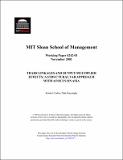| dc.contributor.author | Forbes, Kristin J. | |
| dc.contributor.author | Abeysinghe, Tilak | |
| dc.date.accessioned | 2002-06-05T20:40:52Z | |
| dc.date.available | 2002-06-05T20:40:52Z | |
| dc.date.issued | 2002-06-05T20:41:01Z | |
| dc.identifier.uri | http://hdl.handle.net/1721.1/669 | |
| dc.description.abstract | This paper develops a structural VAR model to measure how a shock to one country
can affect the GDP of other countries. It uses trade linkages to estimate the multiplier
effects of a shock as it is transmitted through other countries' output fluctuations. The
paper introduces a new specification strategy that significantly reduces the number of
unknowns and allows cross-country relationships to vary over time. Then it uses this
model to examine the impact of shocks to 11 Asian countries, the U.S. and the rest of
the OECD. The model produces reasonably good short-term forecasts.
Impulse-response matrices suggest that these multiplier effects are large and significant
and can transmit shocks in very different patterns than predicted from a bilateral-trade
matrix. For example, due to these output-multiplier effects, a shock to one country can
have a large impact on countries that are relatively minor bilateral trading partners. | en |
| dc.format.extent | 378711 bytes | |
| dc.format.mimetype | application/pdf | |
| dc.language.iso | en_US | |
| dc.relation.ispartofseries | MIT Sloan School of Management Working Paper;4242-01 | |
| dc.subject | Output-Multiplier Effects | en |
| dc.subject | VAR | en |
| dc.subject | Trade linkages | en |
| dc.title | Trade Linkages and Output-Multiplier Effects: A Structural VAR | en |
